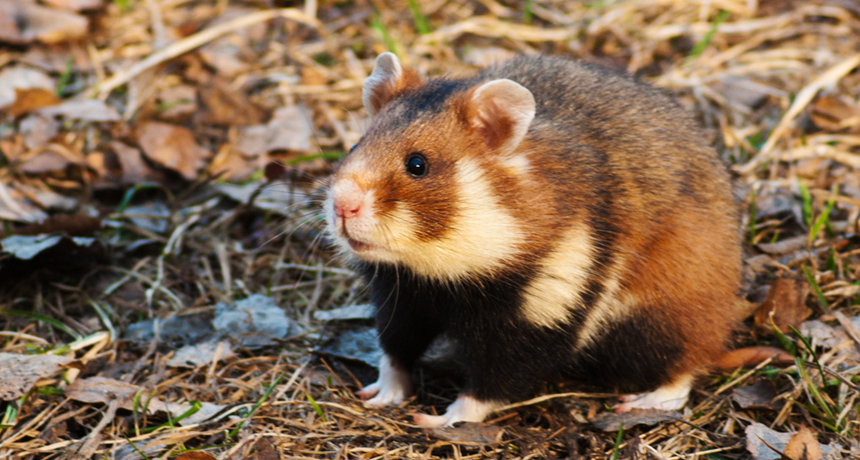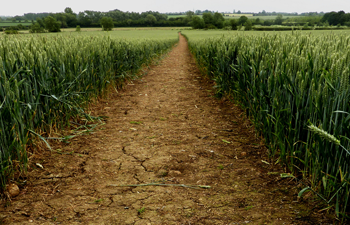Wild hamsters raised on corn eat their young alive
Researchers worry that animals living in corn fields could be deprived of a key vitamin

European hamsters in France often live in farm fields, where they may not be getting a balanced diet. That could cause problems. In the lab, hamsters fed a corn-based diet ate their young alive.
allocricetulus/iStockphoto
People who eat a diet dominated by corn can develop a deadly disease: pellagra. Now something similar has emerged in rodents. Wild European hamsters raised in the lab on a diet rich in corn showed odd behaviors. These included eating their babies! Such behaviors did not show up in hamsters that ate mostly wheat.
Pellagra (Peh-LAG-rah) is caused by a shortage of niacin (NY-uh-sin), which is also known as vitamin B3. The disease has four major symptoms: diarrhea, skin rashes, dementia — a type of mental illness characterized by forgetfulness — and death. Mathilde Tissier and her team at the University of Strasbourg in France never expected to see something similar among rodents in their lab.
As a conservation biologist, Tissier studies species that may face some risk of going extinct and how they might be saved. Her team had been working in the lab with European hamsters. This species was once common in France but has been quickly disappearing. There are now only about 1,000 of the animals left in the whole country. These hamsters also may be on the decline throughout the rest of their range in Europe and Asia.
These animals play an important role in local ecosystems by burrowing. That turning over of the soil as they excavate tunnels can promote soil health. But more than that, these hamsters are an umbrella species, Tissier notes. That means that safeguarding them and their habitat should give benefits to many other farmland species that may also be declining.
Most European hamsters still found in France live around corn and wheat fields. A typical corn field is some seven times larger than the home range for a female hamster. That means the animals that live on a farm will eat mostly corn — or whatever other crop is growing in its field. But not all crops provide the same level of nutrition. Tissier and her colleagues were curious about how that might affect the animals. Perhaps, they guessed, the number of pups in a litter size or how quickly a pup grew might differ if their moms ate different farm crops.

So Strasbourg and her colleagues launched an experiment. They fed lab-reared hamsters wheat or corn. The researchers also supplemented these grains with with either clover or earthworms. That helped the lab diet better match the animals’ normal, omnivorous diets.
“We thought [the diets] would create some [nutritional] deficiencies,” Tissier says. But instead, her team witnessed something quite different. The first sign of this was that some of the female hamsters were really active in their cages. They also were oddly aggressive and didn’t give birth in their nests.
Tissier remembers seeing newly born pups alone, spread across their moms’ cages. Meanwhile, the mothers ran about. Then, Tissier recalls, some hamster moms picked up their pups and placed them in piles of corn they had stored in the cage. Next was the really disturbing part: These moms proceeded to eat their babies alive.
“I had some really bad moments,” Tissier says. “I thought I had done something wrong.”
All female hamsters had reproduced fine. Those fed corn, though, behaved abnormally before giving birth. They also gave birth outside of their nests and most of them ate their young the day after they were born. Only one female weaned her pups. But that didn’t end well either: The two male pups ate their female siblings.
Tissier and her colleagues reported these findings January 18 in the Proceedings of the Royal Society B.
Confirming what went wrong
Hamsters and other rodents are known to eat their young. But only occasionally. This tends to happen only when a baby has died and the mother hamster wants to keep her nest clean, Tissier explains. Rodents do not normally eat live, healthy babies. Tissier spent a year trying to figure out what was going on with her lab animals.
To do this, she and the other researchers reared more hamsters. Again, they fed the rodents corn and earthworms. But this time they supplemented the corn-rich diet with a solution of niacin. And that seemed to do the trick. These moms raised their pups normally, and not as a snack.
Unlike wheat, corn lacks a number of micronutrients, including niacin. In people who subsist on a diet of mostly corn, that niacin deficiency can cause pellagra. The disease first emerged in the 1700s in Europe. That was when corn first became a dietary staple there. People with pellagra developed horrible rashes, diarrhea and dementia. Vitamin deficiency was identified as its cause only in the mid-20th century. Until then, millions of people suffered and thousands died.
(The meso-Americans who domesticated corn usually did not suffer from this problem. That’s because they processed corn with a technique called nixtamalization (NIX-tuh-MAL-ih-zay-shun). It frees up the niacin that is bound in corn, making it available to the body. The Europeans who brought corn back to their home countries didn’t bring back this process.)
The European hamsters fed a corn-rich diet showed symptoms similar to pellagra, Tissier says. And that might also be happening in the wild. Tissier notes that officials with the French National Office for Hunting and Wildlife have seen hamsters in the wild subsisting on mostly corn — and eating their pups.
Tissier and her colleagues now are working to how to improve diversity in farming. They want hamsters — and other wild creatures — to eat a more well-balanced diet. “The idea is not only to protect the hamster,” she says, “but to protect the entire biodiversity and to restore good ecosystems, even in farmland.”







